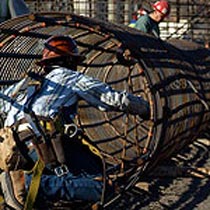State departments of transportation (DOTs) throughout the country are battling the same worsening problems: a lack of funds for road construction and soaring prices for materials like steel and concrete. When funds are available, these rising costs have DOTs scrambling for dollar-stretching ideas.
“Construction costs have almost doubled between 1998 and 2006,” says Ivan Damnjanovic of the Texas Transportation Institute (TTI), who headed up a one-year study for the Texas Department of Transportation (TxDOT) to examine current practices and suggest improvements to the construction process. “DOTs have little control over external factors like the rising cost of fuel and asphalt, but they do have control over the bidding and design process.”
Damnjanovic discovered that not much formal research has been done on cost-cutting methods. As a result, his team’s research could be the most extensive methodological study yet on cost-saving measures in road building. Originally, TxDOT’s Construction Division developed a list of some cost-reduction methods. Then Damnjanovic and his team expanded the list to identify 56 items.
“This report could almost be viewed as an extensive reference guide,” says TxDOT’s Duane Schwarz, project director for the study. “There are so many strategies offered in the report; it helps us to evaluate the way we do business. It puts a lot of ideas into one handy place and is extremely valuable for all of us, but especially for our younger designers.”
Researchers conducted interviews with road construction engineers and fact-finding workshops. Of the 56 methods derived from the study, 21 suggestions would require TxDOT to make policy changes at the program level. On a project-specific level, Damnjanovic and his team identified 35 potential cost-reduction methods that do not require a change in policy.
“In general terms, it’s very important to have a systematic approach to cost reduction,” says TxDOT Research Engineer German Claros. “And this study provides that for us.”
“The purpose of the research was not only to investigate those things that impact prices and methods of lowering those costs, but to make sure the quality of work is not jeopardized as a result,” says Damnjanovic.
Even without implementing any of the cost-reduction techniques outlined in the study, TxDOT received an unexpected gift when fuel prices fell from their $4.00 a gallon peak last summer to under $2.00 in December. “We do expect some of the problems to work their way out of the system,” says Claros. “However, we know that construction costs go up very quickly, and they take a long time to come down.”
DOTs across the country are also breathing a collective sigh of relief about the recently approved stimulus bill that will pump funds into infrastructure improvements. “At this point, there’s a high degree of uncertainty over just how much money we’ll receive, so cost-cutting measures will likely remain a priority,” Claros says.

